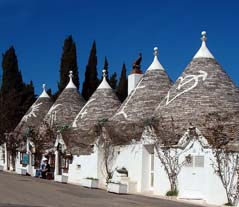 Although it is an UNESCO site, Alberobello is unfortunately rather unknown. In a place of rolling green hills, dotted with almond and olive trees, not far from Bari and Taranto (Apulia), you cannot miss visiting the town, named for the primitive forests of Arboris belli, which once covered the area, where over 1000 trulli mass together.
Although it is an UNESCO site, Alberobello is unfortunately rather unknown. In a place of rolling green hills, dotted with almond and olive trees, not far from Bari and Taranto (Apulia), you cannot miss visiting the town, named for the primitive forests of Arboris belli, which once covered the area, where over 1000 trulli mass together.
Trulli are curious, white, rounded houses, with conical, grey stone roofs; you can admire them only here, in the Valley of Itria. They are built with the dry-stone technique and their architecture is very rustic.
Their origin is unknown, but a story claims that at the very beginning of XVII century, the trulli houses became urban residences for peasants, thanks to an Earl, Jean Jerome Acquaviva, who encouraged them to settle there for tax evasion purposes.
According to an edict issued by the Aragonese family, he was not allowed to build new urban areas without the king’s permission. Moreover, anyone creating a new house had to pay heavy taxes. So peasants built the trulli houses with a dry stone technique and a “pinnacle” on the roof’s top, where a rope was tied.
In case of inspections by the king’s tax collector, they dismantled the houses, sometimes by the help of a horse, pulling the rope and destroying it. As trulli are very rustic, it was then very easy to erect a new trullo on the site of the previous one.
Nowadays, they are firmly planted and buttressed with stucco. Today the most ancient trullo dates 1557, with the year written on the big trullo’s architrave.
The trullo sovrano has been converted into a museum illustrating the history of the trulli.
To read more about Alberobello and Trulli’s history or to plan a trip to Apulia